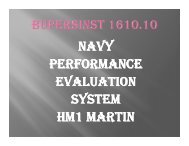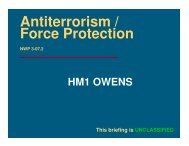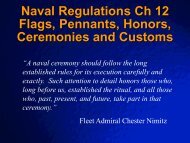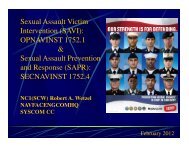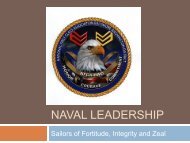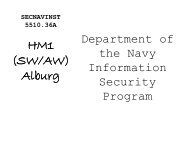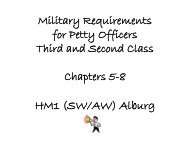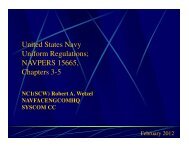NAVEDTRA 14145 Military Requirements for Petty Officer First Class ...
NAVEDTRA 14145 Military Requirements for Petty Officer First Class ...
NAVEDTRA 14145 Military Requirements for Petty Officer First Class ...
Create successful ePaper yourself
Turn your PDF publications into a flip-book with our unique Google optimized e-Paper software.
<strong>NAVEDTRA</strong> <strong>14145</strong><br />
<strong>Military</strong> <strong>Requirements</strong> <strong>for</strong><br />
<strong>Petty</strong> <strong>Officer</strong> <strong>First</strong> <strong>Class</strong><br />
Chapters 4, 6, 7<br />
NC1(SCW) Robert A. Wetzel, USN<br />
NAVFACENGCOMHQ SYSCOM CC<br />
February 2012 1
TOPICS<br />
Chapter 4<br />
Chapter 6<br />
Chapter 7<br />
2
Topic Objectives<br />
Chapter 4: Professional Responsibilities<br />
• Identify the petty officer responsibilities<br />
• Explain how to supervise personnel awarded extra military<br />
instruction (EMI), extension of work hours, or withholding of<br />
privileges<br />
• Describe the various watch organizations<br />
• Identify the personnel qualification standards and<br />
organization<br />
• Explain how to review an enlisted service record<br />
• Describe the personnel advancement requirements system<br />
• Describe the application procedures <strong>for</strong> LDO and CWO<br />
• Identify the duties of the training petty officer<br />
3
Ch 4. Professional Responsibilities<br />
Types of Authority:<br />
General:<br />
OPNAVINST 3120.32B; SORN Article 141.4, 1020, 1122<br />
Organizational:<br />
OPNAVINST 3120.32B; SORN Article 1037<br />
4
Ch 4. Professional Responsibilities<br />
• Limitations of Authority:<br />
• OPNAVINST 3120.32B; SORN Article 1132, 1023<br />
• Article 15 UCMJ<br />
• EMI:<br />
• Not normally longer than 2 hours<br />
• Not to deprive liberty, or Sabbath, but allowed during<br />
after hours<br />
• Duration should reflect the time needed <strong>for</strong> correction<br />
• Authority from CPO’s, PO1’s only if authorized if no CPO<br />
5
Ch 4. Professional Responsibilities<br />
Limitations of Authority Cont:<br />
Withholding of Privileges:<br />
Include: special liberty, exchange of duty, special duty,<br />
special CMD programs, base or ship liberty use, movies,<br />
parking, and special events<br />
Authority is at the discretion of the grantor<br />
Liberty status withholding is with the CO<br />
6
Ch 4. Professional Responsibilities<br />
Limitations of Authority Cont:<br />
Extension of Working Hours:<br />
Guidance under the UCMJ<br />
CO’s grant authority to officers and petty officers<br />
7
Ch 4. Professional Responsibilities<br />
Duties and Responsibilities:<br />
Duties<br />
Div officers duties: SORN<br />
LPO:<br />
<br />
<br />
<br />
<br />
<br />
<br />
Asst. DIVO in preparing watch and liberty lists.<br />
Asst. in assigning personnel and supervisors <strong>for</strong><br />
cleaning duties, and training personnel<br />
Prepares and submits supply requisitions<br />
Assigns tasks and supervises the per<strong>for</strong>mance of<br />
DIV personnel<br />
Supervises the DIV DCPO<br />
And other duties assigned<br />
8
Ch 4. Professional Responsibilities<br />
Duties and Responsibilities Cont:<br />
Assigning DIV Responsibilities:<br />
Qualified personnel<br />
3 step approach; 1. assign personnel 2. assign<br />
supervisor 3. trained replacements<br />
Work Center Supervisors<br />
<br />
<br />
<br />
Responsible <strong>for</strong> their crews<br />
Recommend training and input <strong>for</strong> evaluations<br />
Endorse special request chits<br />
9
Ch 4. Professional Responsibilities<br />
Assignments:<br />
Personnel:<br />
Qualified<br />
Supervisors:<br />
Qualified <strong>for</strong> job and training as well<br />
Make changes to personnel and duties<br />
Replacement Personnel:<br />
Cross training<br />
Unqualified with Qualified<br />
10
Ch 4. Professional Responsibilities<br />
Watch Organization:<br />
<strong>Military</strong> and Administrative<br />
Ship’s watch org. second only to the org <strong>for</strong> battle<br />
Watch’s are responsible <strong>for</strong> the ship, equip. and<br />
personnel<br />
11
Ch 4. Professional Responsibilities<br />
Watch, Quarter, and Station (WQS) Bill:<br />
In<strong>for</strong>m personnel responsibilities<br />
List all pertinent in<strong>for</strong>mation <strong>for</strong> watch personnel<br />
Battle bill, General WQS bill<br />
XO responsible <strong>for</strong> master WQS, DIVO is<br />
responsible <strong>for</strong> their DIV<br />
SORM<br />
12
Ch 4. Professional Responsibilities<br />
Emergency Bills:<br />
General emergency<br />
Man overboard<br />
Chemical, Bio, and Radiological defense<br />
Emergency destruction<br />
Fire<br />
13
Ch 4. Professional Responsibilities<br />
Personnel Qualification Standards:<br />
Qualification goals and time tables<br />
Monitoring/recording qual. Progress<br />
Library of tech references and training materials<br />
Prepare supervisors as PQS qualifiers<br />
Trainees responsible <strong>for</strong> their training<br />
Provide specific knowledge and tasks<br />
14
Ch 4. Professional Responsibilities<br />
Personnel Qualification Standards Cont:<br />
100 Series – Fundamentals<br />
Safety, definitions, other<br />
200 Series – Systems<br />
Component and component parts<br />
300 Series – Watch Station/Maintenance Action<br />
“On Watch”<br />
15
Ch 4. Professional Responsibilities<br />
Implementing PQS:<br />
Indoctrination<br />
Time limits<br />
Process<br />
Interim qualifications<br />
Final certification<br />
Oral Examinations/Written Examinations<br />
16
Ch 4. Professional Responsibilities<br />
Organization:<br />
Qualifiers<br />
Work center Supervisors<br />
DIVO and DIV LCPO<br />
Dept Head<br />
PQS Coordinator<br />
XO/Training <strong>Officer</strong><br />
CO<br />
17
Ch 4. Professional Responsibilities<br />
Enlisted Service Records:<br />
Page 1; DD Form 4, NAVPERS 1070/601,621,622<br />
<br />
<br />
<br />
<br />
<br />
<br />
<br />
<br />
<br />
VA Form 29-8286, SGLI<br />
Page 2; NAVPERS 1070/602 – Dependency<br />
Page 3; NAVPERS 1070/603 – Enlisted classification<br />
Page 4;NAVPERS 1070/604 – Navy Occupation/Training<br />
and Awards History<br />
Page 5; NAVPERS 1070/605 – History of assignments<br />
Page 6; NAVPERS 1070/606 – Unauthorized absence<br />
Page 7; NAVPERS 1070/607 – Court Memorandum<br />
Page 13; NAVPERS 1070/613 – Admin Remarks<br />
Page 14; NAVPERS 1070/614 - Discharge<br />
18
Ch 4. Professional Responsibilities<br />
Chief Warrant <strong>Officer</strong> CWO:<br />
U.S. Citizen<br />
Serving as a CPO (E-7 to E-9)<br />
Physically Qualified<br />
HS diploma or GED<br />
NO disciplinary records <strong>for</strong> 2 years<br />
CO recommendation<br />
12 years but no more than 16<br />
NAVMILPERSCOMINST 1131.1A<br />
Physician Assistant- 60 weeks, NEC 8425, 8420<br />
19
Ch 4. Professional Responsibilities<br />
Limited Duty <strong>Officer</strong>:<br />
<br />
<br />
<br />
<br />
<br />
<br />
<br />
<br />
<br />
<br />
PO1< 1 yr - SCPO and CWO<br />
U.S. Citizen<br />
AC or RC<br />
Physically qualified<br />
HS diploma or GED<br />
NO disciplinary records <strong>for</strong> 2 years<br />
CO recommendation<br />
8 years but no more than 16 years of active Naval service<br />
PO1 must be board eligible<br />
CPO and SCPO may apply <strong>for</strong> both programs: 1 designator<br />
NAVMILPERSCOMINST 1131.1A<br />
20
Ch 4. Professional Responsibilities<br />
Enlisted Commissioning Program:<br />
<br />
<br />
<br />
<br />
<br />
<br />
<br />
<br />
<br />
<br />
<br />
4 year degree earned<br />
After graduation – OCS, AOCS<br />
U.S. Citizen<br />
4 but no more than 11 years of active service<br />
Complete school in 30 or 36 <strong>for</strong> technical degree<br />
22 able to complete commissioning be<strong>for</strong>e 33 years old<br />
2.5 or < on a 4.0 scale<br />
SAT 430v/520m, ACT 19Eng/24Math<br />
Physically qualified<br />
NO disciplinary records <strong>for</strong> 2 years<br />
Recommended by CO<br />
21
Ch 4. Professional Responsibilities<br />
<strong>Officer</strong> Candidate School:<br />
16 weeks, graduate to an ensign USNR<br />
Be an enlisted in any rating or paygrade<br />
19 but not past 29 on commissioning date<br />
Available Hon Discharge w/ 6mths remaining on<br />
AD<br />
OPNAVINST 1120.2A<br />
22
Ch 4. Professional Responsibilities<br />
Training <strong>Petty</strong> <strong>Officer</strong>:<br />
Develop training schedules<br />
Schedule training events and lectures, GMT<br />
Record training in records<br />
23
Ch 4. Professional Responsibilities<br />
Presenting Personnel <strong>for</strong> Quarters, Inspection, and<br />
Ceremonies:<br />
Quarters:<br />
Fair/foul weather parade, personnel inspection,<br />
mustering on station<br />
General assembly<br />
Locker and Seabag inspection, NAVPERS 15665G<br />
24
Topic Objectives<br />
Chapter 6: Safety and Survival<br />
<br />
<br />
<br />
<br />
<br />
<br />
<br />
<br />
<br />
<br />
Identify the DIV safety petty officer responsibilities<br />
Explain mishap prevention education and training<br />
Describe the 3 types of safety observations<br />
Describe the purpose of job safety analysis<br />
Explain the purpose of the enlisted safety committee<br />
Explain Navy’s Occupational Safety & Health (NAVOSH)<br />
Identify the responsibilities - Hazardous Waste/Material PO<br />
Safety precautions when working w/ industrial equip and<br />
HAZMAT<br />
Types of respirators and their uses<br />
Navy’s Hearing Conservation, Noise Abatement, and Sight<br />
Protection<br />
25
Topic Objectives Cont<br />
Chapter 6: Safety and Survival<br />
<br />
<br />
<br />
Describe the Navy’s Equipment Tag-out Program<br />
Types of survival situations and the responsibilities of the<br />
senior PO<br />
State the methods of survival<br />
26
Chapter 6: Safety and Survival<br />
Division Safety <strong>Petty</strong> <strong>Officer</strong>:<br />
Safety Duties:<br />
Increase safety awareness, conduct investigations, give<br />
recommendations, and asst. DIVO w/ safety duties<br />
Safety in<strong>for</strong>mation:<br />
OPNAVINST 5100.23B- NAVOSH, Occup., rec., aviation<br />
NAVSEA SE000-00-EIM-100, electrical<br />
OPNAVINST 5100.19B, afloat<br />
OPNAVINST 5100.12F, motor vehicle<br />
<strong>NAVEDTRA</strong> 10808-2, Navy Safety Sup<br />
27
Chapter 6: Safety and Survival<br />
Mishap Prevention, Education, and Training:<br />
Safety Education:<br />
Training material; film, safety notes, various pubs,<br />
lectures<br />
On-the-job Training:<br />
Monitoring, knowledge<br />
28
Chapter 6: Safety and Survival<br />
Safety Observations:<br />
Incidental; noticing safety violation without being<br />
deliberate<br />
Deliberate; purposely observing<br />
Planned; schedule<br />
What jobs to observe; priority of observation<br />
29
Chapter 6: Safety and Survival<br />
Job Safety Analysis:<br />
Identify possible hazards or mishaps, Develop<br />
solutions<br />
Mishap Prevention; spot and eliminate potential<br />
causes<br />
Basic steps:<br />
Select job, Break down job, Identify, Develop Solutions<br />
Best use; initial training, regular safety contacts,<br />
pre-job safety INST, cost-reduction studies<br />
30
Chapter 6: Safety and Survival<br />
Enlisted Safety Committee:<br />
CO, DIV Safety PO, Chief MAA, Recorder<br />
MAA/Safety Force:<br />
Roving inspectors<br />
Safety En<strong>for</strong>cement:<br />
Continually monitor measures<br />
31
Chapter 6: Safety and Survival<br />
Navy Occupational Safety and Health (NAVOSH):<br />
All are responsible under the UCMJ<br />
Industrial Equipment Safety Precautions:<br />
OPNAVINST 3120.32B Lock-out, Tag-out<br />
Pneumatic tools<br />
Protective Clothing and Safety Equipment:<br />
Semi conductive safety shoes<br />
Molders’ “congress” style shoes<br />
Rubber or synthetic material<br />
Gloves<br />
Hearing protection<br />
32
Chapter 6: Safety and Survival<br />
Navy Occupational Safety and Health (NAVOSH)<br />
Cont:<br />
Hazardous Material:<br />
Prohibited (except pharmacies, clinics, cargo);<br />
Trichloroethylene, Benzene, Beta naphthylamine,<br />
Carbon tetrachloride, DDT emulsion, Hydrocyanic acid<br />
gas, Insecticides or DDT, Methyl Bromide, Plastic trash<br />
cans, Tetrachloroethane, Dry-cleaning solvent<br />
33
Chapter 6: Safety and Survival<br />
Hazardous Waste/Material <strong>Petty</strong> <strong>Officer</strong>:<br />
Labeling, handling, and storage<br />
Asbestos<br />
Removing Asbestos:<br />
Physical exam of personnel<br />
3 qualified personnel and 1 Supervisor<br />
PPE; overalls, head covering, gloves, booties - cover<br />
openings<br />
Provide air line<br />
Wet Asbestos be<strong>for</strong>e removal<br />
34
Chapter 6: Safety and Survival<br />
Hazardous Waste/Material <strong>Petty</strong> <strong>Officer</strong> Cont:<br />
Respiratory Protection: Safety or Damage Control<br />
PO does:<br />
Annual training<br />
Issues respirators<br />
Monitors use, cleaning and reissue, monthly report<br />
Continued availability<br />
35
Chapter 6: Safety and Survival<br />
Hazardous Waste/Material <strong>Petty</strong> <strong>Officer</strong> Cont:<br />
Types of respirators<br />
Air-Purifying<br />
Supplied-Air<br />
Self-Contained Breathing Apparatus (SCBA)<br />
IDLH- Immediate Dangerous to life or Health Situations<br />
ID of Respirator cartridges and Gas Mask<br />
canisters:<br />
Color coded gray or natural metallic color with label<br />
36
Chapter 6: Safety and Survival<br />
Heat Stress:<br />
Heat exhaustion and heat stroke<br />
Education of program<br />
Heat stress surveys:<br />
Area’s dry bulb temp exceeds 100 degrees F<br />
Conditions of unusually high heat or moisture<br />
Be<strong>for</strong>e conducting engineering casualty drills<br />
Operations in hot, humid climates<br />
Per<strong>for</strong>mance of exceptionally arduous work<br />
During engineering plant restoration after actual<br />
casualties<br />
37
Chapter 6: Safety and Survival<br />
Sight Conservation:<br />
Program<br />
20/200 in one eye, visually impaired<br />
OPNVAINST 5100.23B or .19B<br />
38
Chapter 6: Safety and Survival<br />
Equipment Tag-Out Log:<br />
Record sheet: DANGER/CAUTION, Cleared<br />
Instrument Log:<br />
Out-of-Commission and Out-of-Calibration<br />
Record sheets:<br />
2,000-3,000 tags<br />
Where, date, time, and reason <strong>for</strong> tag out.<br />
Date, time, initials <strong>for</strong> removal<br />
Audits:<br />
Every 2 weeks<br />
39
Chapter 6: Safety and Survival<br />
Survival:<br />
Key is Attitude:<br />
Traits;<br />
Courage, Determination, Cheerfulness, Costiveness,<br />
Flexibility, Willingness, Purpose, Attentiveness,<br />
Confidence, Productiveness, Persistence, Certainty<br />
Authority of Senior Person in this situation:<br />
<br />
Navy Reg. & article IV Code of Conduct<br />
Ashore: Environment vs. Specific Qualities<br />
Evasion:<br />
Observation and Your Footprint<br />
Position, shape, shadow, color<br />
40
Chapter 6: Safety and Survival<br />
Survival :<br />
Prisoner-of-War (POW) Camp:<br />
Code of Conduct<br />
LTJG Dieter Dengler, POW 6 month<br />
At Sea:<br />
Afloat and safe, take charge and remain calm<br />
Group Survival:<br />
Best chance = Together<br />
Organize, assign, assume command & COC, Respect,<br />
decisions.<br />
41
Chapter 6: Safety and Survival<br />
Survival:<br />
Basic Elements:<br />
Size up the situation<br />
Undue haste makes waste<br />
Remember where you are<br />
Vanquish fear and panic<br />
Improvise<br />
Value living<br />
Act like the Natives<br />
Learn basic skills<br />
Summary: NEVER GIVE UP HOPE<br />
42
Topic Objectives<br />
Chapter 7: Damage Control<br />
<br />
<br />
<br />
<br />
<br />
<br />
<br />
<br />
<br />
<br />
Describe the objectives of damage control<br />
D- the DC responsibilities of the COC<br />
D- DC organization<br />
D- duties of the repair parties<br />
D- duties of the on-scene leader<br />
D- duties of the at-sea fire party<br />
D- procedures <strong>for</strong> investigating flooding, structure damage,<br />
fires<br />
ID- classes of fire and extinguishing agents <strong>for</strong> DC<br />
D- methods to prevent the spread of fires<br />
D- methods to control flooding<br />
43
Topic Objectives Cont<br />
Chapter 7: Damage Control<br />
<br />
<br />
<br />
<br />
D- two types of flooding<br />
ID- types of DC communications<br />
D- purpose and rules observed <strong>for</strong> first aid<br />
D- hazards with nuclear weapons mishap incident<br />
44
Chapter 7: Damage Control<br />
Objectives of Damage Control (DC):<br />
Prevention, Minimization, Restoration<br />
Responsibilities:<br />
CO- maintain<br />
XO- readiness<br />
OOD- responsible to the CO<br />
DIVO- their divisions<br />
Work Center DCPO:<br />
<br />
Same duties as the DCPO<br />
45
Chapter 7: Damage Control<br />
Objectives of Damage Control (DC) Cont:<br />
DCPO:<br />
<br />
<br />
<br />
<br />
<br />
<br />
<br />
<br />
<br />
<br />
<br />
Familiar with phases of ships DC, fire-fighting,<br />
defense procedures.<br />
Training<br />
Prep and maintenance <strong>for</strong> check-off lists<br />
Sup. the setting of DC conditions with-in spaces<br />
Weighing portable CO2 bottles<br />
Ensuring all equipment is in place<br />
Ensuring all equipment if labeled and ID<br />
Posting safety procedures and operating INST<br />
Asst. DIVO w/ inspections<br />
Conduct daily inspections<br />
Other duties assigned<br />
46
Chapter 7: Damage Control<br />
Damage Control Organization:<br />
DC Battle ORG:<br />
Damage Control Center (DCC), Secondary DCC<br />
Functions of the DCC; hub of the ship’s DC ef<strong>for</strong>ts<br />
Repair Party Assignments:<br />
DIVO to assign qualified personnel from PQS<br />
Dress <strong>Requirements</strong> <strong>for</strong> Repair Parties:<br />
Cover body, tee shirt, sleeves down, trousers tucked in<br />
Life jackets<br />
Protective headgear<br />
Protective masks<br />
47
Chapter 7: Damage Control<br />
Damage Control Organization Cont:<br />
Repair parties and teams:<br />
Repairs to electrical and sound powered telephone<br />
circuits<br />
<strong>First</strong> aid and transport of injured<br />
Detecting, ID, and measuring dose and dose-rate from<br />
rad.<br />
Sampling/ID of bio or chemical agents<br />
Control and extinguishing of all fires<br />
Evaluating and recording damage:<br />
<br />
Graphic display, Deck plans, and casualty board<br />
48
Chapter 7: Damage Control<br />
Damage Control Organization Cont :<br />
Setting Material Condition Zebra:<br />
Max protection in Battle<br />
DCC sets X-ray and Yoke that were logged open<br />
“Manned and Ready”, “Set Zebra”<br />
Repair Party Org. <strong>for</strong> Fire Fighting:<br />
Plan of action<br />
Indoc and trained<br />
Divide large repair parties into two<br />
Battle Dressing Stations; minimum of two<br />
49
Chapter 7: Damage Control<br />
On-Scene Leader:<br />
Takes charge of fire fighting party, asst. repair<br />
party leader<br />
At-Sea Fire Party<br />
Respond immediately to fires<br />
Extinguish small fires w/o disturbing ops.<br />
Control fire until ops can fully stop and GQ can be M&R<br />
Red painted steel helmet marked front and back w/ one<br />
inch black letter ID the repair party. One inch reflective<br />
horizontal stripes in white, red, white<br />
Investigating Damage:<br />
Must be thorough, conducted w/ caution, results rpt<br />
clearly and quickly, and must be repeated<br />
50
Chapter 7: Damage Control<br />
On-Scene Leader Cont:<br />
Investigation teams:<br />
Each repair unit has 4 investigators<br />
Two man OBA Tenders<br />
D ring on OBA if investigator going alone<br />
Initial/Rapid Survey; investigations <strong>for</strong> sudden changes<br />
Repeat/Detailed Investigations, conducted ASAP in<br />
greater detail, all compartments with-in 50 feet of damaged<br />
area<br />
Investigation <strong>for</strong> flooding:<br />
Complete emersion generally = open to the sea<br />
Slow could mean pipe or small hole<br />
Pipe rupture could cause pressure 100 lbs or more<br />
51
Chapter 7: Damage Control<br />
On-Scene Leader Cont:<br />
Investigation <strong>for</strong> Structural Damage:<br />
Considerable area around damaged location<br />
Bulkhead damage, hot electrical, hot bearings on motors<br />
reported immediately<br />
Investigation of Fires:<br />
Damage and causes<br />
Indicators of present fires<br />
Reporting In<strong>for</strong>mation:<br />
Immediate action to isolate<br />
Report to parent party, DCC, CO<br />
Most damage obvious within minutes<br />
52
Chapter 7: Damage Control<br />
On-Scene Leader Cont:<br />
Benefits of investigation:<br />
<strong>First</strong> two steps; Put out fires and control flooding<br />
w/o investigation something may go unnoticed<br />
Could waste time on repair not needed or impossible<br />
53
Chapter 7: Damage Control<br />
Fire Fighting:<br />
Extinguish quickly to prevent further damage<br />
Initial Fire-Fighting Ops:<br />
Determine location and type<br />
Then method of extinguishing<br />
CO2 Safety Precautions:<br />
Replaces oxygen<br />
Cannot be seen or smelled<br />
Remains close to the surface<br />
OBA<br />
Wait 15 unless emergency<br />
Static electric charge<br />
54
Chapter 7: Damage Control<br />
Fire Fighting Cont:<br />
Halon 1301 Hazards:<br />
Decomposes at 900 degrees F<br />
Byproducts; hydrogen fluoride and hydrogen bromide<br />
Stay out unless w/ OBA<br />
Allowed 5-7% <strong>for</strong> up to 10 min<br />
Direct contact is extremely cold, obscures vision<br />
Preventing Spreading of Fires:<br />
Secure breaches in bulkheads, cool adjacent bulkheads,<br />
remove combustibles from near compartments<br />
Render compartments safe by; cool or smother w/ fog, fill<br />
w/ CO2, flood as practical<br />
55
Chapter 7: Damage Control<br />
Fire Fighting Cont:<br />
Post-fire Action:<br />
Set reflash watches<br />
Test <strong>for</strong> explosive gases, oxygen content, in that order<br />
Overhaul the fire<br />
Retest <strong>for</strong> gases<br />
Desmoke and test again<br />
56
Chapter 7: Damage Control<br />
Flooding Control:<br />
Two methods:<br />
Restrict or entirely stop water flow<br />
Confine and remove water that has entered or still is<br />
Preparatory Measures, be<strong>for</strong>e damage:<br />
90% of DC be<strong>for</strong>e damage<br />
Education about ship<br />
Speed and accuracy<br />
Learn effects of a torpedo hit<br />
Prepare materials; watertight integrity, classify closures<br />
and fittings, properly set material conditions of closures,<br />
provide adequate and well-distributed DC equipment<br />
57
Chapter 7: Damage Control<br />
Flooding Control Cont:<br />
Types of flooding:<br />
Solid; completely flooded<br />
Partial; partially flooded<br />
Establishing Flood Boundaries<br />
Holding What You Have; don’t ignore hidden<br />
damage<br />
Holes in Underwater Hull:<br />
Fix in dry dock<br />
Plug and empty water<br />
Water pressure and accessibility<br />
58
Chapter 7: Damage Control<br />
Flooding Control Cont:<br />
Rate of flooding; area of hole and the square root of its<br />
depth<br />
Methods Used to Control Flooding;<br />
Flooding reduced by 50% = controlled by portable pumps<br />
Plugs <strong>for</strong> small holes; unpainted wood w/lightweight cloth<br />
Pillows, mattresses backed up with patch or shoring<br />
Find anything that works<br />
Holes in Hull Above the Water Line:<br />
Plug at once<br />
Give higher priority (light given out)<br />
Source of DC Info:<br />
DC library, Schooling <strong>for</strong> key members, Table 7-6<br />
59
Chapter 7: Damage Control<br />
Damage Control Communications:<br />
Ships Communication Devices:<br />
Battle telephone circuits (sound powered)<br />
<br />
<br />
Primary during battle or combating damage<br />
Sound Powered Circuits:<br />
Main 2JZ, 3, 4, 5, 6,7<br />
<br />
<br />
<br />
<br />
<br />
JA (Captain’s battle circuit),<br />
JV (Maneuvering),<br />
2JV (Engineer’s),<br />
X-40J (Casualty communication)<br />
4MC DC intercom<br />
60
Chapter 7: Damage Control<br />
Damage Control Communications Cont:<br />
Inter-station two-way systems (intercoms)<br />
Ship’s loud speaker system (general announcing)<br />
Ship’s service telephones<br />
Voice tubes (where installed)<br />
Messengers; rely on oral orders even w/ written orders<br />
61
Chapter 7: Damage Control<br />
Personnel Casualty Control:<br />
<strong>First</strong> Aid:<br />
Purpose; save life, prevent further injury, preserve<br />
resistance and vitality<br />
Rules:<br />
<br />
<br />
<br />
<br />
<br />
<br />
<br />
<br />
<br />
<br />
Keep patient laying down, head level to start<br />
Examine in this order; breathing, hemorrhage, shock<br />
Remove clothing; rip alone seams, limit removal<br />
Remain clam; quickly but efficiently<br />
Keep the patient com<strong>for</strong>table<br />
Do not allow the patient to see the injury<br />
Keep open wounds and burns as clean as possible<br />
No liquids<br />
No Morphine to unconscious person<br />
Do not move, unless needed<br />
62
Chapter 7: Damage Control<br />
Nuclear Weapons Accident/Incident:<br />
High Explosives:<br />
Varying amount up to 200 lbs<br />
Treat accident and fires as conventional high explosives<br />
If on fire it could explode<br />
Only trained personnel<br />
Plutonium:<br />
May be released as small particles<br />
Only dangerous if it enters the body; inhaled, cuts<br />
63
Chapter 7: Damage Control<br />
Response to a Nuclear Weapon Accident/Incident:<br />
Treat the same as any shipboard emergency<br />
Sound GQ, pass alarm<br />
React<br />
No foam on warheads<br />
Respiratory protection<br />
Stay Back<br />
64
Chapter 7: Damage Control<br />
CBR Defense:<br />
DC and personnel protective measures used to<br />
combat/minimize the effects of CBR<br />
Radiological Defense:<br />
Effects:<br />
Ship/Equipment<br />
Personnel<br />
Per<strong>for</strong>mance of electronics, electrical, and Comm’s equip<br />
Nuclear and thermal radiation<br />
Air blast and underwater shock more damaging<br />
65
Chapter 7: Damage Control<br />
Radiological Defense Cont:<br />
Nuclear Weapon Hazards:<br />
Distance of damage<br />
Injuries from; air blast, underwater shock, thermal and<br />
nuclear radiation<br />
Damage-Survival Zone:<br />
Distance<br />
<br />
<br />
<br />
Kill Zone; Heavy damage<br />
D-S Zone; Moderate to light damage<br />
Naval <strong>for</strong>mations; most ships in the D-S Zone<br />
66
Chapter 7: Damage Control<br />
Radiological Defense Cont:<br />
Non-Nuclear damage effects:<br />
Air blast:<br />
<br />
<br />
<br />
<br />
Pressure blast by air explosion<br />
Nuclear; up to 10 miles from burst<br />
Time to impact; seconds to one minute<br />
Damage to waterline and above<br />
Underwater shock:<br />
<br />
<br />
<br />
<br />
On or below the surface<br />
Mimics depth charge<br />
Travels faster than Air burst; one to ten seconds<br />
Damage to structure, personnel, equipment<br />
67
Chapter 7: Damage Control<br />
Radiological Defense Cont:<br />
Water Waves:<br />
<br />
<br />
<br />
<br />
Could reach up to 100 feet high<br />
Damage possible up to 10 miles<br />
Arrival; 30 seconds to several minutes<br />
Possibly only damage, flooding<br />
68
Chapter 7: Damage Control<br />
Radiological Defense Cont:<br />
Protection Against Air burst, Heat, and<br />
Underwater Shock:<br />
“Warning” and “No Warning”, Topside and Below-deck<br />
Open Topside Areas:<br />
<br />
<br />
<br />
<br />
Flash/sky light up- close eyes cover face<br />
Drop, use shoulder to break fall, curl up<br />
Grab structure to avoid effects from winds<br />
Blindness up to 30 seconds<br />
Congested area- follow same procedures if possible<br />
Underwater- grab hold of structure, bend knees, rest on<br />
the balls of feet<br />
69
Chapter 7: Damage Control<br />
Radiological Defense Cont:<br />
Self and <strong>First</strong> Aid:<br />
<br />
<br />
<br />
<br />
Self aid- applies to aid given to yourself<br />
<strong>First</strong> aid- assistance given<br />
Immediate treatment <strong>for</strong> radiation sickness not<br />
needed<br />
Decontamination stations- removal of clothing,<br />
equipment and shower<br />
70
Chapter 7: Damage Control<br />
Nuclear Radiation:<br />
Initial Radiation<br />
Gamma rays, Neutrons<br />
Emitted in minutes, Gone within seconds<br />
Effects personnel more<br />
Shielding<br />
Radioactive Fallout<br />
Occurs minutes to hours after burst<br />
Size and location effect distance and amount<br />
Weather effects distance of particles<br />
71
Chapter 7: Damage Control<br />
Nuclear Radiation Cont:<br />
Types of Radiation Emitted by Contamination:<br />
Alpha<br />
<br />
Beta<br />
<br />
Particles; only hazardous in it enters the body<br />
Can be stopped with dense material<br />
Gamma (similar to X Rays)<br />
<br />
Highly penetrating, most dangerous<br />
72
Chapter 7: Damage Control<br />
Chemical and Biological Defense:<br />
Biological Warfare:<br />
Use of living infectious microorganisms (germs) to<br />
reduce or destroy the military effectiveness of personnel<br />
Detection and ID; incubation period<br />
Dissemination; aerosols of solid or liquid particles<br />
<br />
No explosives<br />
Self-Aid; Protective mask, report immediately, observe<br />
73
Chapter 7: Damage Control<br />
Chemical and Biological Defense Cont:<br />
Chemical Warfare:<br />
Use in military operations to kill, injure seriously, or<br />
incapacitate people through physiological effects<br />
Characteristics:<br />
<br />
<br />
Surprise, travel, penetrate, economical, large area<br />
Lethal/incapacitating, morale/psychological, impact<br />
on medical/logistic effects<br />
<strong>Class</strong>ification:<br />
<br />
Casualty Agents<br />
<br />
<br />
serious injury or death<br />
Nerve, blood, choking, and blister<br />
74
Chapter 7: Damage Control<br />
Chemical and Biological Defense Cont:<br />
<br />
<br />
Effects<br />
<br />
<br />
<br />
Incapacity Agents; temporary<br />
Riot Agents; tear gas<br />
Hospitalization<br />
Inhalation of high concentrations = death<br />
Nerve<br />
<br />
<br />
<br />
<br />
Most dangerous<br />
Inhale lethal dose 5-10 seconds<br />
Death possible in 6 minutes<br />
<strong>First</strong> sign, stop breathing, don protective mask<br />
75
Chapter 7: Damage Control<br />
Chemical and Biological Defense Cont:<br />
<br />
<br />
<br />
MCU-2/P (mask)<br />
M-258A1 Decontamination kit, skin decon<br />
<br />
DO Not Use; eyes, wounds, mouth<br />
Atropine injection and 2-PAM chloride<br />
<br />
<br />
<br />
<br />
Inject outer thigh<br />
10 minutes inject again<br />
Additional 10 minutes, one atropine<br />
No more than 3 injections unless supervised by<br />
medical personnel<br />
76
Chapter 7: Damage Control<br />
Chemical and Biological Defense Cont:<br />
<br />
Blister agent:<br />
<br />
<br />
<br />
<br />
<br />
<br />
<br />
<br />
Incapacitating<br />
Smell, garlic, fish, geraniums<br />
Colorless – dark brown oily liquid/ droplets<br />
React almost immediately<br />
Treatment after 2 minutes is of little use<br />
Flush w/ large amounts of water<br />
Eyes or skin deal w/ first<br />
No vapor? Still do decontamination<br />
77
Chapter 7: Damage Control<br />
Chemical and Biological Defense Cont:<br />
<br />
<br />
Choking agent:<br />
<br />
<br />
<br />
Death may occur within minutes - 3 hours<br />
Colorless, detect by odor- new-mown hay/grass<br />
Poss. delay 3 hours or more<br />
Blood agents:<br />
<br />
<br />
<br />
<br />
<br />
Least persistent<br />
Colorless, odor of bitter almonds<br />
Lethal dose = death within 15 minutes<br />
Speed and self-aid essential<br />
If possible leave area<br />
78
Chapter 7: Damage Control<br />
Chemical and Biological Defense Cont:<br />
<br />
<br />
Vomiting agent:<br />
<br />
<br />
Harassment<br />
Colorless/odorless<br />
Tear agents:<br />
<br />
<br />
<br />
Harassment<br />
Riot control and chemical def training<br />
Instantaneous lasting only a few minutes<br />
79
Chapter 7: Damage Control<br />
Chemical and Biological Defense Cont:<br />
Personal Decontamination Stations<br />
<br />
<br />
<br />
<br />
<br />
<br />
Differ from ship to ship<br />
Two parts; a contaminated or unclean section<br />
containing a washing area, a clean section<br />
8-9 feet<br />
Entrance and exit near showers<br />
No not remove mask until told<br />
Decon<br />
<br />
<br />
<br />
<br />
<br />
Remove gear<br />
gross decon. mask, gloves boots<br />
Removal of suit, boots and clothes<br />
Showers; hidden areas<br />
Clean; new clothing, observation<br />
80
Chapter 7: Damage Control<br />
Chemical and Biological Defense Cont:<br />
Mission Oriented Protective Posture (MOPP):<br />
MOPP LVL -1:<br />
<br />
Protective equip issued, mask fitted <strong>for</strong> use, suit/<br />
boots/gloves/mask located at battle station<br />
MOPP LVL -2:<br />
<br />
<br />
Suit donned, hood down<br />
Rest carried<br />
MOPP LVL -3:<br />
<br />
<br />
Suit/boots donned, hood down<br />
Mask has canister fitted<br />
MOPP LVL -4:<br />
<br />
<br />
Suit/boots/gloves/mask donned, hood up and secure<br />
Exposed topside personnel w/ rain gear<br />
81
Chapter 7: Damage Control<br />
Disaster Control Ashore:<br />
Disaster preparedness<br />
Promote survival of personnel, preservation of resources,<br />
restoration of mission-essential operations following a disaster<br />
Phase I (Planning):<br />
<br />
Location, equipment, supplies<br />
Phase II (Investigation of Extent of Disaster):<br />
<br />
Survey team, personnel/helicopters<br />
Phase III (Initial Disaster Relief):<br />
<br />
Rescue, fires, medical aid, aid relief situation<br />
Phase IV (Routine Aid and Asst.)<br />
<br />
Continue medical/rescue work, provide food/supplies, repair<br />
comm’s/water/elec., temp shelter<br />
Phase V (Withdrawal)<br />
82
PO1 <strong>Requirements</strong>: Ch 4, 6-7<br />
Thank you.<br />
Any Questions?<br />
83




